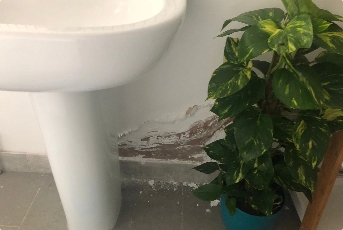Rising Damp: Signs, Causes, and Prevention Tips
Rising damp is a common nuisance that affects properties across the UK. Thankfully, there are ways to identify rising damp so steps can be taken to address the root causes. This article explores the tell-tale signs of rising damp, what causes it to occur and provides useful tips on how to prevent and treat it.
What is Rising Damp?
Rising damp occurs when ground moisture rises up into the floors and walls of a building. This moisture comes from rain and groundwater.
If left untreated, rising damp can cause significant damage to the fabric of a building. Rot can develop in timber elements and mould growth can pose health risks for occupants. Thankfully, there are ways to identify and treat rising damp.
Signs of Rising Damp
Here are the tell-tale signs of rising damp to look out for:
- Tide marks – Horizontal lines appear on walls up to 1 metre above the floor. These stains indicate the height that moisture has reached.
- Crumbling and loose plaster – As moisture penetrates the plaster, salts dissolve and recrystallise, causing it to crumble and flake away from the wall.
- Peeling wallpaper – Wallpaper can bubble and peel away from damp walls as moisture soaks through.
- Musty smells – The dampness allows mould and fungi to breed, creating a musty smell.
- Rotting skirting boards – Skirting boards, wooden door frames and other timber components rot over time.
What Causes Rising Damp?
There are a few typical causes of rising damp:
- Lack of a damp proof course (DPC) – Older buildings often lack a DPC to prevent moisture rising up through walls.
- Bridging – When a DPC exists but is compromised by contact with the damp ground or materials that allow moisture to cross over it.
- Blocked air bricks – Air bricks allow ventilation under floors but can become clogged over time.
- High external ground levels – Soil, path levels or rendered surfaces raised against the exterior walls drives moisture up.
- Leaking pipes or wastes – Any water penetration like leaking pipes or overflowing wastes adds to the problem.
How to Prevent and Treat Rising Damp
Here are some tips to tackle rising damp:
- Install a new DPC – For older buildings, retrofitting a new chemical DPC injected into the walls stops rising damp.
- Improve ventilation – Ensure good airflow under floors by clearing debris from air bricks and vents.
- Reduce external ground levels – Move path levels, soil and rendered surfaces away from the external walls where possible.
- Fix leaks and overflows – Promptly repair any plumbing issues and check waste outlets.
- Treat affected walls – Once the source of damp is addressed, walls can be treated with fungicidal washes to remove mould and allow to dry out.
- Replaster and redecorate – After drying out, walls may need plaster repairs and new damp-resistant coatings before redecoration.
Rising damp can cause major damage if left unchecked. But getting to the root cause and making appropriate repairs can stop it in its tracks. Acting promptly when the early signs appear will prevent costly repairs later on. With vigilance and the right remedial work, rising damp can be effectively managed in any home.
